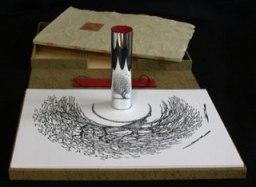
The Directed Gaze: Ursula K. LeGuin's Direction of the Road, illustrated with an anamorphic woodcut by Aaron Johnson
The word anamorphosis comes from the Greek: ana -back, and morphe -form. Viewed from a specific vantage point, the distorted image recovers a recognizable form, and often seems to lift up from the actual surface.
Anamorphic forms and devices were explored extensively during the Renaissance as scientists and artists attempted to understand how vision and perspective worked. Illustrations of early anamorphic devices by Leonardo Da Vinci, Egnatio Danti, and Pietro Accolti are displayed along with artist Aaron Johnson's contemporary anamorphic woodcut, that accompanies a special publication of Ursula K. Le Guin's short story, the Direction of the Road.
Le Guin's story of a tree's perspective of the changing 20th century world around it is perhaps uniquely suited to anamorphic illustration.